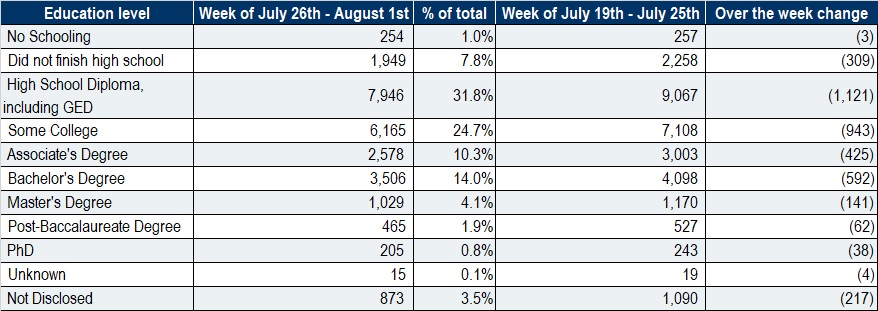Initial unemployment insurance claims for week of July 26 – August 1, 2020
Employment Security Department
20-041
FOR IMMEDIATE RELEASE – August 6, 2020
CONTACTS
Media inquiries: media@ESD.WA.GOV
All unemployment claims decreased from the previous week
OLYMPIA – During the week of July 26 through August 1, there were 24,985 initial regular unemployment claims (down 13.4% from the prior week) and 656,556 total claims for all unemployment benefit categories (down 3.1% from the prior week) filed by Washingtonians, according to the Employment Security Department (ESD).
- Initial regular claims applications remain at elevated levels and are at 346 percent above last year’s weekly new claims applications.
- Regular Unemployment Insurance, Pandemic Unemployment Assistance (PUA) and Pandemic Emergency Unemployment Compensation (PEUC) initial claims as well as continuing claims all decreased over the previous week.
ESD paid out over $575.5 million for 444,580 individual claims – an increase of $2.2 million and 2,394 more individuals compared to the prior week.
|
Unemployment claim type |
Week of July 26-August 1 |
Week of July 19-July 25 |
Week of July 12-July 18 |
|
Regular Unemployment Insurance (UI) initial claims |
24,985 |
28,840 |
29,348 |
|
Pandemic Unemployment Assistance (PUA) initial claims |
4,613 |
6,133 |
6,827 |
|
Pandemic Emergency Unemployment Compensation (PEUC) initial claims |
6,695 |
7,031 |
7,177 |
|
Continued/ongoing weekly claims |
620,263 |
635,351 |
630,092 |
|
Total claims |
656,556 |
677,355 |
673,444 |
Since the week ending March 7 when COVID-19 job losses began:
- A total of 2,333,456 initial claims have been filed during the pandemic (1,473,262 regular unemployment insurance, 460,478 PUA and 399,716 PEUC)
- A total of 1,287,949 distinct individuals have filed for unemployment benefits
- ESD has paid out over $9.2 billion in benefits
- 985,689 individuals who have filed an initial claim have been paid
“Getting benefits to all eligible Washingtonians has been, and continues to be, our agency’s top priority,” said ESD Commissioner Suzi LeVine. “As we turn the page on Operation 100%, more than 81,500 individuals who had applied by mid-June and not received payment now have resolution on their claims. You can see this reflected in this week’s data, as claims went down but dollars out went up. While clearing this initial backlog represents significant progress, and more than 980,000 individuals have received benefits since the crisis began, we know we still have a lot more work to do and a lot of trust to be regained as we move into the next phase of our response. There are still those who have applied since mid-June or had issues set on their weekly claims and need resolution. We will leverage the progress made and lessons learned in Operation 100% to help those individuals and resolve claims faster moving forward. In a continued commitment to transparency, we have launched a new benefits data dashboard that we will update each week. This will help our customers and the public stay up to speed on our status, progress and performance of claims processing as the pandemic continues.”
Below is a twenty-two-week summary of statewide initial claims filed since the start of the COVID-19 crisis:
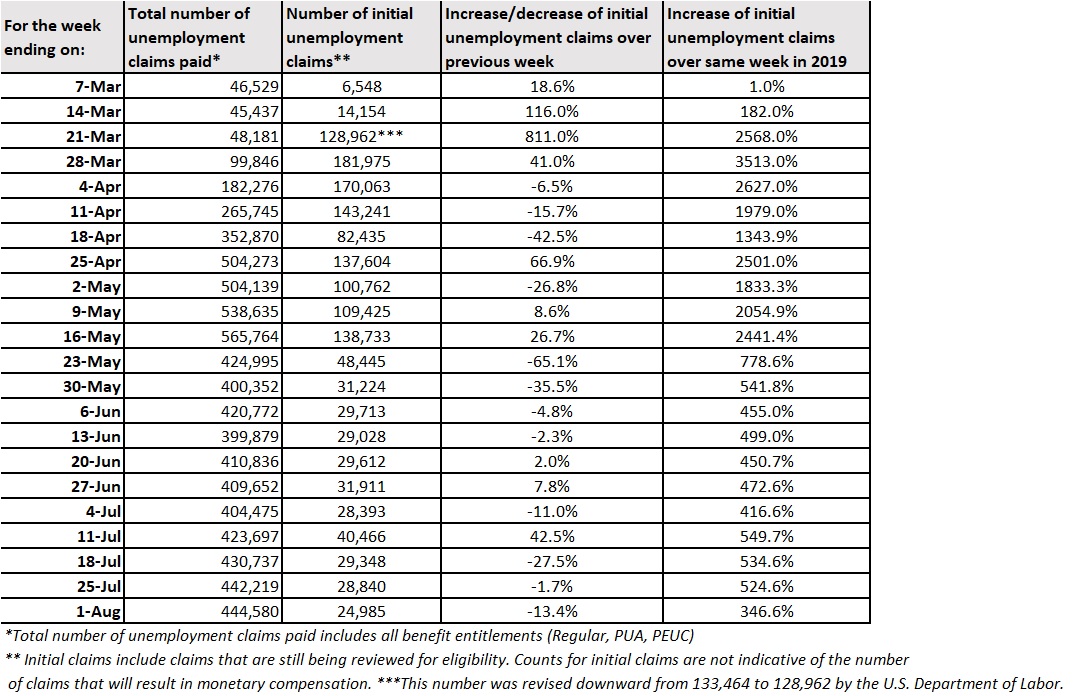
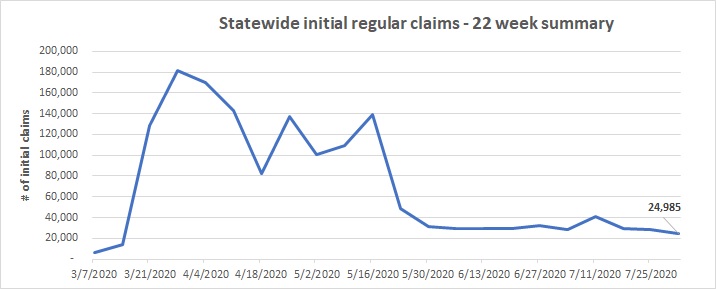
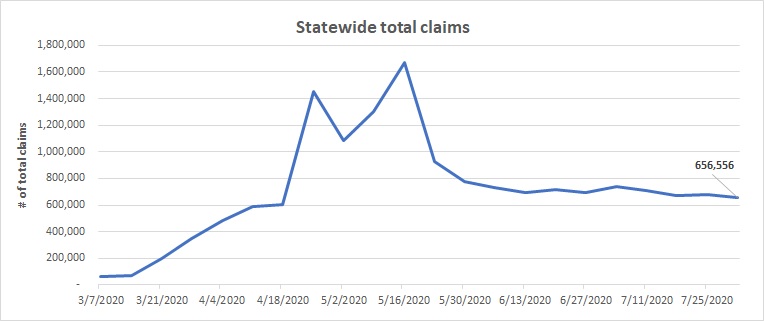
Weekly data breakdown
By industry
Industry sectors experiencing the highest number of initial claims during July 26- August 1 were:
- Accommodation and food services: 2,863 initial regular claims, down 277 (-9 percent) from previous week
- Health care and social assistance: 2,374 initial regular claims, down 408 (-5 percent) from the previous week
- Retail trade: 2,049 initial regular claims, down 238 (-10 percent) from previous week
- Manufacturing: 2,018 regular initial claims, up 33 (2 percent) from the previous week
- Construction: 1,985 initial regular claims, down 250 (-11 percent) from the previous week
By occupation
- Food preparation and serving: 2,854 regular initial claims, down 431 (-13 percent) from previous week
- Management occupations: 2,809 regular initial claims, down 338 (-11 percent) from the previous week
- Construction and extraction occupations: 2,312 regular initial claims, down 368 (-14 percent) from the previous week
- Office and administrative support: 2,199 regular initial claims, down 372 (-14 percent) from previous week
- Transportation and material moving occupations: 1,799 regular initial claims, down 293 (-14 percent) from the previous week
By county
King County, the most populous in the state saw initial regular claims decrease from 7,818 to 6,676 during the week of July 26- August 1, down 15 percent from the week before.
Other counties with the largest number of initial claims during the week were:
- Pierce County: Initial regular claims filed decreased from 3,753 to 3,127 down 17 percent from the week before.
- Snohomish County: Initial regular claims filed decreased from 3,199 to 2,899 down 10 percent from the week before.
- Spokane County: Initial regular claims filed decreased from 1,927 to 1,599 down 17 percent from the week before.
- Clark County: Initial regular claims filed increased from 1,362 to 1,147 down 16 percent from the week before.
Demographic breakdown – complete charts are provided in Appendix A below (This information is asked during the application process).
During the week of July 26- August 1:
- By gender: 50.7 percent (12,676) of the initial regular claims were filed by females while 48.9 percent (12,207) were filed by males
- By age group: 26.2 percent (6,557) of initial regular claims were filed by the 25-34 years old age group, followed by 21.5 percent (5,369) by the 35-44 years old age group and 18.3 percent (4,576) by the 45-54 years old age group.
- By education level: 31.8 percent (7,946) of initial regular claims were filed by individuals with a high school diploma, included GED, followed by 24.7 percent (6,165) with some college and 14.0% (3,506) with a bachelor’s degree.
- By race/ethnicity: 60.0 percent (15,003) of initial regular claims were filed by Caucasians, followed by 7.5 percent (1,872) filed by Asians, 6.3 percent filed by Black/African Americans (1,577) and 6.3 percent filed by Latino/Hispanics (1,579).
- By disability status: 3.2 percent (798) of initial regular claims were from individuals identified as having a disability, including 0.9 percent (218) who identified themselves as disabled veterans.
- By veteran’s status: 5.1 percent (1,282) of initial regular claims were filed by veterans, including 106 initial regular claims from individuals eligible for veterans benefits due to family relations with a veteran.
SharedWork
For employers looking to avoid layoffs or slowly ramp up re-hiring during this crisis, SharedWork is a great program that can help. You can learn more at esd.wa.gov/SharedWork
|
|
Week of July 26 – August 1 |
Week of July 19 – 25 |
During height of the recession |
|
Employers with an approved SharedWork plan |
3,451 employers covering 152,668 employees |
3,416 employers covering 152,824 employees |
2,500 employers covering approximately 46,000 employees |
|
Individuals who filed weekly claims for the SharedWork program |
66,712
|
65,387 |
46,000 |
Please see new charts in the Appendix A below. For complete information of weekly initial claims by industry sector and county for the year to date, also check the weekly unemployment initial claims charts compiled by ESD’s Labor Market & Economic Analysis division. For more information about specific counties, contact one of ESD’s regional local economists.
NOTE: ESD will send out the next weekly new claims press release on Thursday, August 13 at 10 a.m. Pacific Time.
Data disclaimer and definitions
Per U.S. Department of Labor regulations, weekly unemployment claims data is embargoed and not available for release until the Thursday following the claim week.
Initial claims include individuals who filed first-time claims as well as additional claims filed by individuals as a result of a new unemployment event. Initial claims include claims that are still being reviewed for eligibility. Counts for initial claims are not indicative of the number of claims that will result in monetary compensation.
Continuing claims equal continued weeks claimed including a total of all weeks for which benefits were claimed, even though such benefits were not paid or payment status is uncertain or unknown, e.g., waiting weeks, partial weeks, weeks for which penalties are being served and weeks for which a monetary or nonmonetary issue is pending.
Pandemic Unemployment Assistance (PUA) is an emergency program established by the federal CARES Act that temporarily expands unemployment insurance eligibility to self-employed workers, freelancers, independent contractors, and part-time workers impacted by the coronavirus pandemic in 2020.
Pandemic Emergency Unemployment Compensation (PEUC) is an emergency program established by the federal CARES Act that extends unemployment insurance for an extra 13 weeks to those who have exhausted their regular unemployment benefits.
Federal Pandemic Unemployment Compensation (FPUC) is an emergency program established by the CARES Act to increase unemployment benefits for Americans who are out of work because of the COVID-19 pandemic. Under FPUC, eligible people who collect certain unemployment insurance benefits—including regular unemployment compensation—will get an extra $600 in federal benefits each week through the week ending July 25, 2020.
COVID-19 resources
State of Washington’s coronavirus website
Washington state Department of Health public health resources
Labor market web links
- Labor market information website
- Historical data(Excel spreadsheet)
- Current claims data
- Historical claims data(Excel spreadsheets)
Appendix A
Initial regular claims by industry sector
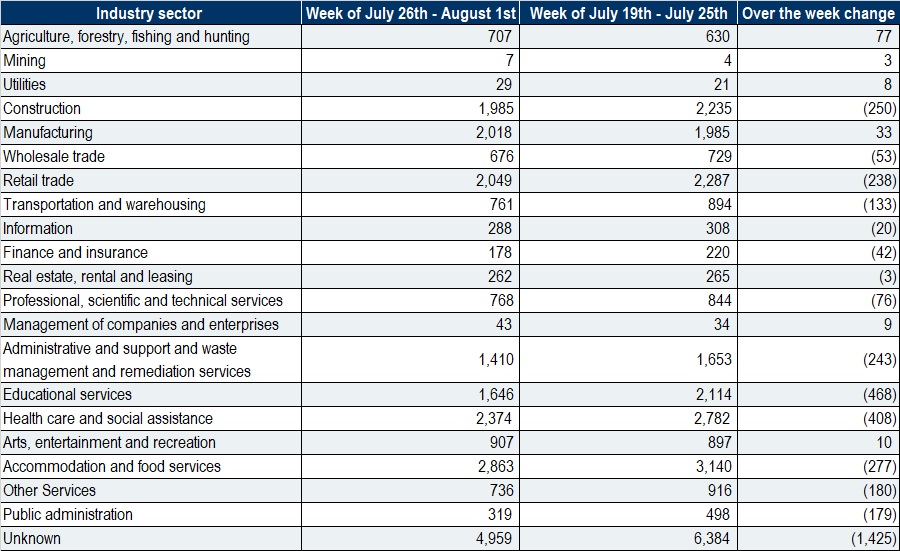
Initial regular claims by occupation
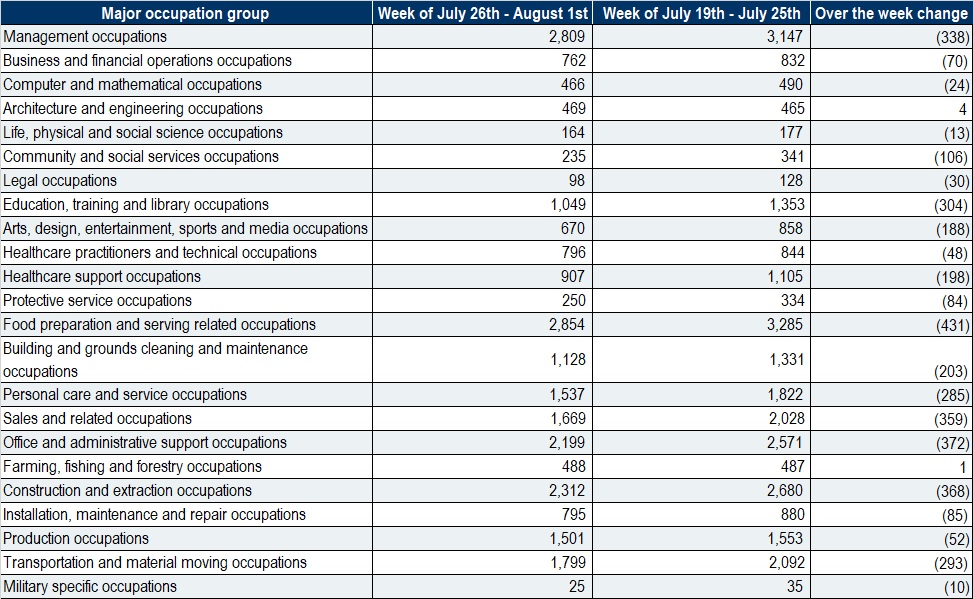
Initial regular claims by county
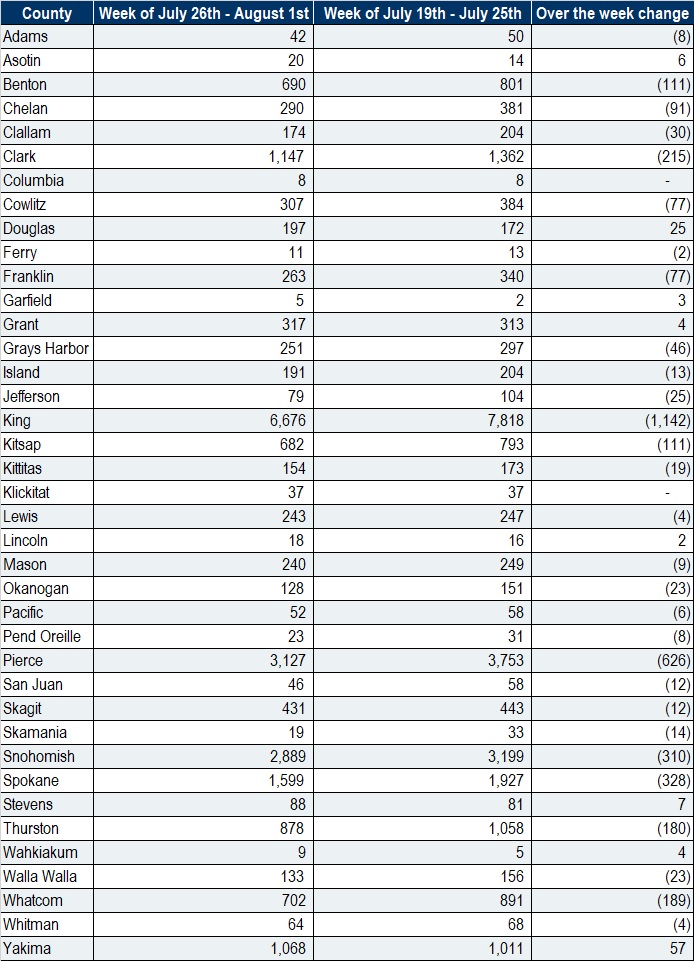
Initial regular claims by gender

Initial regular claims by  age group
age group
Initial regular claims by race/ethnicity

Initial regular claims by Veteran status

Initial regular claims by disability status

Initial regular claims by education level
